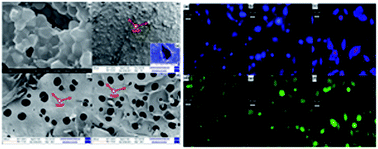Development of new graphene oxide incorporated tricomponent scaffolds with polysaccharides and hydroxyapatite and study of their osteoconductivity on MG-63 cell line for bone tissue engineering
Abstract
Regenerative medicine witnessed a paradigm shift from synthetic implants and tissue grafts to a tissue engineering approach that incorporates biodegradable, bioceramic composite scaffolds with biological cells. A combination of carbon nanomaterials and hydroxyapatite (HAP) with polysaccharides holds a great potential in bone tissue engineering. In the present study, new porous tricomponent scaffolds, graphene oxide (GO)–gellan–HAP, GO–alginate–HAP and GO–amylopectin–HAP were prepared by freeze drying method. The ionic interactions between the individual components in the formation of the composites were confirmed by FTIR and XRD. The porous morphology of scaffolds was confirmed by FE-SEM images. Osteoconductivity and biocompatibility of scaffolds on MG 63 cell line were confirmed by in vitro MTT assay. The increased mineralization could be visualized by alkaline phosphatase (ALP) activity. Among the scaffolds, the GO–amylopectin–HAP exhibited higher biocompatibility, mineralization and cell attachment. The compressive strength values were determined and found to be 466.8 ± 19 for GO–gellan–HAP, 171 ± 17 for GO–alginate–HAP and 161 ± 4 for GO–amylopectin–HAP scaffolds. The higher biocompatibility, mineralization and cell attachment and lower compressive strength for GO–amylopectin–HAP was attributed to higher pore size and porosity. These results indicated that the prepared tricomponent scaffolds could be used as promising biomaterials in tissue engineering.


 Please wait while we load your content...
Please wait while we load your content...